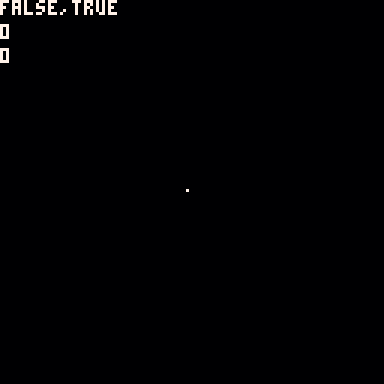can someone tell me why this always fails?
it isn't garenteed to always reach 63,63 even through i floor it.
function main()
domain=true
while domain do
cls()
spr(16,4,0,15,2)
for i=0,8 do star() end
yield()
end
end
function star()
dostar=true
inst =
{
sx=rnd(127),
sy=127,
ex=63,
ey=63,
}
while dostar do
local dx=flr(inst.sx)==flr(inst.ex)
local dy=flr(inst.sy)==flr(inst.ey)
rectfill(0,0,127,24,0)
print(tostr(dx)..","..tostr(dy),0,0,7)
if dx and dy then
dostar=false
else
pset (inst.sx,inst.sy,7)
print(flr(inst.sx).."/"..flr(inst.ex),0,8,7)
print(flr(inst.sy).."/"..flr(inst.ey),0,16,7)
inst.sx+=(inst.ex-inst.sx)*mainstarspd
inst.sy+=(inst.ey-inst.sy)*mainstarspd
end
yield()
end
end |

Try printing out these two values:
print((inst.ex-inst.sx)*mainstarspd) print((inst.ey-inst.sy)*mainstarspd) |
I suspect one of the values is small enough that the multiply underflows and the result is a 0 offset that keeps you from arriving at the end value.
Remember (or discover now) that PICO-8 uses signed 16.16-bit fixed point math. You only have 16 bits of fractional precision. If you were, for instance, to square any number less than than 1/256 (0x.01), you'd get 0.

@Felice i can't print it out without it flowing offscreen or clearing over the previus number.
it updates too fast.

[Please log in to post a comment]






